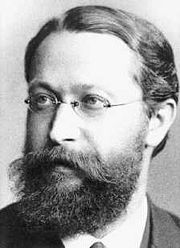Karl Ferdinand Braun
| Karl Ferdinand Braun | |
|---|---|
 |
|
| Born | 6 June 1850 Fulda, Hessen-Kassel, Germany |
| Died | 20 April 1918 (aged 67) Brooklyn, New York, USA |
| Nationality | German |
| Fields | Physics |
| Institutions | University of Karlsruhe University of Marburg University of Strassburg University of Tübingen University of Würzburg |
| Alma mater | University of Marburg University of Berlin |
| Doctoral advisor | August Kundt |
| Doctoral students | Leonid Isaakovich Mandelshtam Albert Schweizer |
| Known for | Cathode ray tube, Cat's whisker diode |
| Notable awards | Nobel Prize in Physics (1909) |

Karl Ferdinand Braun (6 June 1850 – 20 April 1918) was a German inventor, physicist and Nobel laureate in physics. Braun contributed significantly to the development of the radio and TV technology: he shared with Guglielmo Marconi the 1909 Nobel Prize in Physics.
Contents |
Biography
Braun was born in Fulda, Germany, and educated at the University of Marburg and received a Ph.D. from the University of Berlin in 1872. In 1874 he discovered that a point-contact semiconductor rectifies alternating current. He became director of the Physical Institute and professor of physics at the University of Strassburg in 1895.
In 1897 he built the first cathode-ray tube and cathode ray tube oscilloscope. CRT technology is only now, over a century later, gradually being replaced by flat screen technologies (such as LCD, LED and Plasma) on television sets and computer monitors. The CRT is still called the "Braun tube" (Braunsche Röhre) in German-speaking countries (and in Japan: Buraun-kan).
During the development of radio, he also worked on wireless telegraphy. Around 1898, he invented a crystal diode rectifier or Cat's whisker diode. Guglielmo Marconi used Braun's patents (among others). Braun's British patent on tuning was used by Marconi in many of his tuning patents. Marconi would later admit to Braun himself that he had "borrowed" portions of Braun's work. In 1909 Braun shared the Nobel Prize for physics with Marconi for "contributions to the development of wireless telegraphy."
Braun went to the United States at the beginning of World War I (before the U.S. had entered the war) to help defend the German wireless station at Sayville, New York, against attacks by the British-controlled Marconi Corporation. After the US entered the war, Braun was being detained, but could move freely within Brooklyn, New York. Braun died in his house in Brooklyn, before the war ended in 1918.
Patents
- U.S. Patent 0,750,429, Wireless Electric Transmission of Signals Over Surfaces
- U.S. Patent 0,763,345, Means for Tuning and Adjusting Electric Circuits
See also
- History of radio
- Invention of radio
- Edouard Branly
References
- K.F. Braun: "On the current conduction in metal sulphides (title translated from German into English)", Ann. Phys. Chem., 153 (1874), 556. (In German) An English translation can be found in "Semiconductor Devices: Pioneering Papers", edited by S.M. Sze, World Scientific, Singapore, 1991, pp. 377-380.
- Keller, Peter A.: The cathode-ray tube: technology, history, and applications. New York: Palisades Press, 1991. ISBN 0-9631559-0-3.
- Keller, Peter A.: "The 100th Anniversary of the Cathode-Ray Tube," Information Display, Vol. 13, No. 10, 1997, pp. 28-32.
- F. Kurylo: "Ferdinand Braun Leben und Wirken des Erfinders der Braunschen Röhre Nobelpreis 1909", München: Moos Verlag, 1965. (In German)
External links
- "Ferdinand Braun – Biography". Nobel Lectures. Physics 1901-1921, Elsevier Publishing Company, Amsterdam, 1967.
- Naughton, Russell, "Karl Ferdinand Braun, Dr : 1850 - 1918".
- "Karl Ferdinand Braun ". Biographies of Famous Electrochemists and Physicists Contributed to Understanding of Electricity.
- Rybak, James P., "Forgotten" Pioneers of Wireless; Part 5 - Karl Ferdinand Braun".
- "Karl Ferdinand Braun, 1850-1918". (German) (English translation)
- The Ferdinand-Braun-Institut fuer Hoechstfrequenztechnik Berlin, Germany
- Alfred Thomas Story A Story of Wireless Telegraphy. D. Appleton and company 1904
|
||||||||||||||||||||